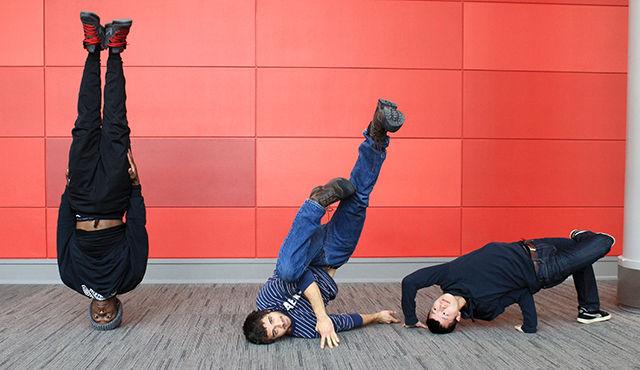Breakdancing usually isn’t the first thing to come to mind when constructing your doctoral dissertation.
But for Daniel Synk, a teaching assistant and Ph.D. candidate in the communication, rhetoric and digital media program at NC State, his research led him to consider the relationship between media technology and breakdance culture.
During his time in the CRDM program, Synk took a class about communication and network society that required him to gather some kind of empirical data for a paper. Coming from a background studying English, he said gathering quantitative data was something new, so he decided to take some of the media ideas he was exposed to and apply them to something he had been exposed to in high school.
“I had friends in high school who would break and I would just be hanging out with them either while they were practicing or while they were watching videos of competitions,” Synk said. “I started thinking about the roles that media play in B-Boy culture.”
Synk said that sharing breakdancing VHS tapes was a big part of the culture.
“Tapes would get passed around and they were sort of expensive so people wouldn’t really buy them,” he said. “They were not necessarily hard to get your hands on, but a lot less easy to get your hands on than YouTube is currently.”
Synk said he is looking at how changes in media technologies change how people learn to do different types of embodied performance. In particular, he is looking at how YouTube affects current B-Boy culture.
So far in his research, Synk said older breakers, who are generally between the ages of 27 and 33, have consistently felt that digital streaming has had a detrimental influence on the way breakdancing is perceived by younger generations learning it for the first time.
“They would attribute a causal role to YouTube causing younger breakers to treat the dance more instrumentally instead of being a cultural expression, to think of it as a sport,” he said.
In addition to concerns about how younger breakers were approaching the dance, Synk said there was also concern that YouTube was having an effect on the dances themselves.
“They also attributed to YouTube the breaking down of regional styles,” Synk said. “So where, previously, different parts of the country had distinctive characteristics of how people would dance, YouTube was homogenizing the dance stylistically across geographic areas.”
Still in the process of gathering data, Synk said he is interested to see if breakers within younger generations perceive themselves the way older generations do.
“What I have not figured out yet and what I’m interested in looking into is whether this negative influence that older breakers are perceiving matches up with younger breakers self-perceptions, if they think about things in the way that older breakers are saying that they think about things,” he said.
Peter Vu, a senior studying chemical engineering and president of the Break-Fast Club, NC State’s only B-Boy club on campus, said he got into breaking as a result of wanting to broaden his horizons.
“I was sitting down at home one day and all of the sudden I thought, ‘I want to learn something new,’” Vu said. “I looked up tutorial videos to how to do some breaking steps, and from there I practiced on my own for a little bit and tried to just learn off of YouTube until I met a group of people that actually did it and I started practicing with them more.”
Vu said breakdancing is an art and a form of self-expression.
“It gives the people who do it an opportunity to really explore their creativity because you can utilize so many different parts of your body,” he said. “You can basically use everything, and you can use that without being afraid of being judged.”
Alex Olosu, a sophomore studying textile technology and a member of the Break-Fast Club, said that in addition to being among the most physically demanding forms of dancing, breaking is a way of infusing artistic creativity to the fullest extent in a departure from other forms of dancing that rely more on a set choreography.
“With breaking, literally there are no bounds in which you can perform and create your own style and dance,” Olosu said.
Samuel Jacobs, a junior studying mechanical engineering and also a member of the Break-Fast Club, said that for him breaking is a way to get to know others and understand more about where they come from.
“You can actually tell what a person is like by how they break sometimes,” Jacobs said. “You also get to see different styles and get to see different techniques and get to learn about different cultures behind these people through breakdancing, so it’s a medium to get to know people.”
Synk said his research into the relation between media and B-Boy culture has been both fun and challenging given that he is looking at the performing breakers do as a type of rhetoric.
“You get to see people moving their bodies in ways that seem impossible and everyone’s just having a good time, so it’s a pretty fun topic to research from that perspective,” he said. “The most difficult thing for me has been figuring out how to position myself as a researcher working in the middle of multiple different disciplines.”








